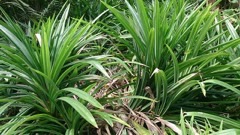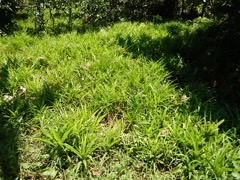 |
|
commons.wikimedia.org |
 |
| commons.wikimedia.org/wiki/User:Judgefloro |
Translate this page:
Summary
Physical Characteristics

 Pandanus amaryllifolius is an evergreen Tree growing to 4 m (13ft) by 3 m (9ft) at a medium rate.
Pandanus amaryllifolius is an evergreen Tree growing to 4 m (13ft) by 3 m (9ft) at a medium rate.
See above for USDA hardiness. It is hardy to UK zone 9.
Suitable for: light (sandy), medium (loamy) and heavy (clay) soils. Suitable pH: mildly acid, neutral and basic (mildly alkaline) soils. It can grow in semi-shade (light woodland) or no shade. It prefers moist or wet soil.
UK Hardiness Map
US Hardiness Map
Synonyms
P. hasskarlii Merr. P. latifolius Hassk. [Illegitimate]. P. latifolius var. minor Hassk. P. odorus Ridl.
Plant Habitats
Edible Uses
Edible Parts: Fruit Leaves Seed
Edible Uses: Colouring Condiment
The fragrant young leaves are cooked and eaten [301 ]. They are also often used, both fresh or dried, to flavour rice, cassava etc., especially in sweet dishes [296, 301 ]. Juice extracted from leaves is used to add fragrance to various types of teas and desserts. Desserts include cakes and kueh. The aromatic leaves give a garlic-like flavour to food [238 ]. Delicious, they add a distinctive musky odour and a natural green colour [296, 301 ]. The chlorophyll pigments in the leaves will colour foods green. The leaves are also used to wrap other foods, such as rice dumplings [301 ]. The leaves are not consumed but are removed from the dish before serving. In Indonesia, rice is sometimes steamed in baskets made of the leaves. Thai people wrap the leaves around pieces of seasoned chicken and then fry them. In Southeast Asia, the leaves are often used to make small boxes or containers that can hold pudding or jellies. Although no specific records have yet been seen for this species, most members of this genus have more or less edible fruits, seeds and inner leaf bases [193 ]. The cylindrical fruit is a syncarp made up of several individual drupes [193 ]. Individual drupes are hard, woody wedges - each containing a few slender seeds [193 ]. Each wedge has a fleshy base imbued with a sweet-smelling, orange pulp that, in many species, has a delicious flavour[193 ]. This pulp needs to be cooked to destroy a harmful substance [193 ]. The seed often has a delicious nutty flavour when eaten raw or cooked, though it is fiddly to extract [193 ]. Seeds contain 44 - 50% fat and 20 - 34% protein [193 ]. The inner base of young leaves - raw [193 ].
References More on Edible Uses
Medicinal Uses
Plants For A Future can not take any responsibility for any adverse effects from the use of plants. Always seek advice from a professional before using a plant medicinally.
Antibacterial Antidermatosic Antifungal Antirheumatic Cardiotonic Deodorant Diuretic Hypoglycaemic
The leaves are diuretic and cardiotonic [317 ]. An infusion is used as a sedative against restlessness and is also a traditional treatment for diabetes [310 ]. Externally, the leaves are used in the treatment of skin diseases; as a relaxing soak to counter restlessness [310, 317 ]. They are soaked in coconut oil; the oil is then employed as an embrocation for rheumatic troubles [310 ]. Three piperidine alkaloids have been isolated and identified from the leaves of fragrant pandan. The application of the leaves as an antidiabetic drug seems linked to 4-hydroxybenzoic acid, which has been isolated from Pandanus amaryllifolius roots [310 ]. It shows hypoglycaemic effects and increases serum insulin levels and liver glycogen content [310 ].
References More on Medicinal Uses
The Bookshop: Edible Plant Books
Our Latest books on Perennial Plants For Food Forests and Permaculture Gardens in paperback or digital formats.

Edible Tropical Plants
Food Forest Plants for Hotter Conditions: 250+ Plants For Tropical Food Forests & Permaculture Gardens.
More

Edible Temperate Plants
Plants for Your Food Forest: 500 Plants for Temperate Food Forests & Permaculture Gardens.
More

More Books
PFAF have eight books available in paperback and digital formats. Browse the shop for more information.
Shop Now
Other Uses
Basketry Containers Cosmetic Deodorant Essential Insecticide Pot-pourri Preservative Repellent Weaving
The aromatic leaves are used for perfume [317 ]. In Thailand, cab drivers use pandan leaves as a natural air freshener. Freshly chopped leaves are mixed with the petals of various flowers to make potpourris [317 ]. It has been speculated that the scent in fragrant pandan leaves is not an essential oil but a volatile product of oxidative degradation of a yellow carotenoid pigment [310 ]. The leaves do, however, yield a tiny amount of essential oil [310 ]. The leaves can be woven into small baskets [310 ]. They are used to make containers for desserts [317 ]. The leaves are used to make mats for sleeping on [454 ]. An extract of the leaves is used as an ingredient in commercial cosmetic preparations as a deodorant and masking agent [1243 ]. The essential oil has insect-repellent activity, for instance, against the ordinary cockroach, Periplaneta americana [310 ]. Pandan leaves, and the extract is used as food preservatives due to their antibacterial and antifungal properties (particularly against mould). Bottled pandan extract is available in shops and often contains green food colouring. The powdered leaves may be used as a repellent against Callosobruchus chinensis infestation of mung-bean seeds [310 ].
Special Uses
Food Forest Scented Plants
References More on Other Uses
Cultivation details
Fragrant Pandan is a plant of the humid lowland tropics. Apart from the continuous harvesting of fragrant pandan, there are some indications that ever-wet climatic conditions are less favourable for the large growth form's development, thus assisting in perpetuating the small growth form [310 ]. Fragrant Pandan succeeds in full sun or light shade in moderately fertile, well-drained soil [200 ]. Fragrant pandan tolerates shade very well [310 ]. Continual harvesting of the leaves from the shrub form will prevent it from developing into the tree form [310 ]. When abandoned or allowed to develop without hindrance, it grows very slowly but eventually will enter into the 'large' growth phase and develop a stout trunk [310 ]. The odour of the leaves remains the same in both growth forms [310 ]. Harvesting of fragrant pandan may start about six months after planting and may continue for several years [310 ]. Individual leaves are cut, leaving the top with 3 - 4 leaves intact [310 ]. Branches do not have dormant buds and will not resprout if cut back into the old wood [423 ]. A one-ha plot in the Philippines, with fragrant pandan under pepper and some fruit trees, was harvested twice a week, yielding 60 kg of fresh leaves per harvest, or 6 t/ha per year [310 ]. A dioecious species, but only the male form is known, so seeds cannot be produced[317 ]. Can be grown in pots (35L+)
References Carbon Farming Information and Carbon Sequestration Information
Temperature Converter
Type a value in the Celsius field to convert the value to Fahrenheit:
Fahrenheit:
The PFAF Bookshop
Plants For A Future have a number of books available in paperback and digital form. Book titles include Edible Plants, Edible Perennials, Edible Trees,Edible Shrubs, Woodland Gardening, and Temperate Food Forest Plants. Our new book is Food Forest Plants For Hotter Conditions (Tropical and Sub-Tropical).
Shop Now
Plant Propagation
Seed is not available for this plant because only male forms are known[317 ]. Suckers during the growing season. Suckers removed from the leaf axils can be planted straight away or rooted in a sandy medium[310 ]. Cuttings of lateral shoots. Stem cuttings should be inserted obliquely in the planting medium[310 ].
Other Names
If available other names are mentioned here
Fragrant screw pine, Pandanus amaryllifolius, Bai toey hom, Bai toey, Ban lan ye, Boro, Curry leaf, Daun pandan, Hedan, La dua, Pandan bau, Pandan rampai, Pandan wangi, Pandan, Pandano, Pandanus leaf, Raampa, Raampe faiy, Rampe, Taey, Toei hom [1-4]
Native Range
AUSTRALASIA: Maluku
Weed Potential
Right plant wrong place. We are currently updating this section.
Please note that a plant may be invasive in one area but may not in your area so it's worth checking.
None Known
Conservation Status
IUCN Red List of Threatened Plants Status : Not Listed.

Growth: S = slow M = medium F = fast. Soil: L = light (sandy) M = medium H = heavy (clay). pH: A = acid N = neutral B = basic (alkaline). Shade: F = full shade S = semi-shade N = no shade. Moisture: D = dry M = Moist We = wet Wa = water.
Now available:
Food Forest Plants for Mediterranean Conditions
350+ Perennial Plants For Mediterranean and Drier Food Forests and Permaculture Gardens.
[Paperback and eBook]
This is the third in Plants For A Future's series of plant guides for food forests tailored to
specific climate zones. Following volumes on temperate and tropical ecosystems, this book focuses
on species suited to Mediterranean conditions—regions with hot, dry summers and cool, wet winters,
often facing the added challenge of climate change.
Read More
Expert comment
Author
Roxb.
Botanical References
Links / References
For a list of references used on this page please go here
A special thanks to Ken Fern for some of the information used on this page.
Readers comment
| Add a comment |
|
If you have important information about this plant that may help other users please add a comment or link below. Only comments or links that are felt to be directly relevant to a plant will be included. If you think a comment/link or information contained on this page is inaccurate or misleading we would welcome your feedback at [email protected]. If you have questions about a plant please use the Forum on this website as we do not have the resources to answer questions ourselves.
* Please note: the comments by website users are not necessarily those held by PFAF and may give misleading or inaccurate information.
To leave a comment please Register or login here All comments need to be approved so will not appear immediately.
|
Subject : Pandanus amaryllifolius
|
|
|
|